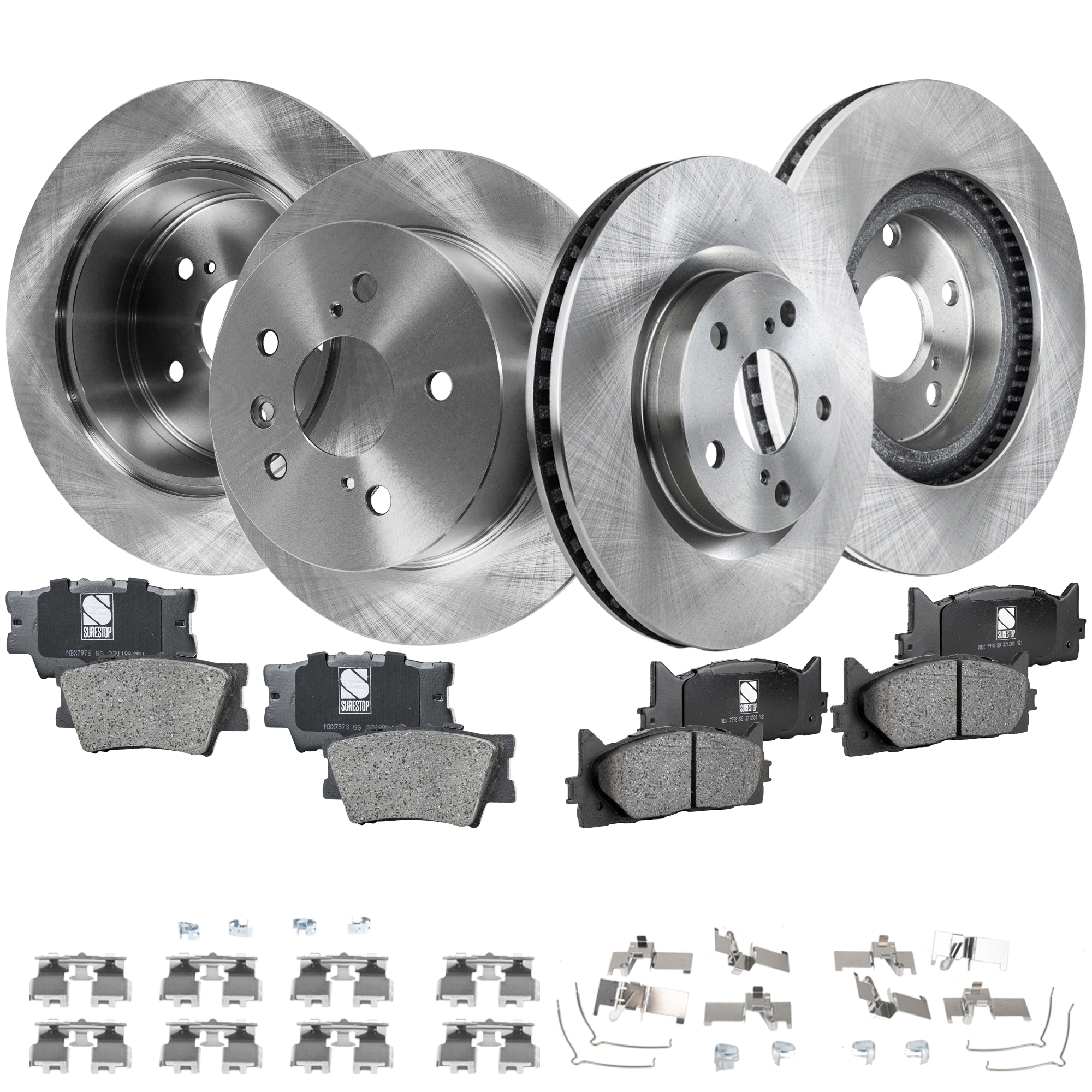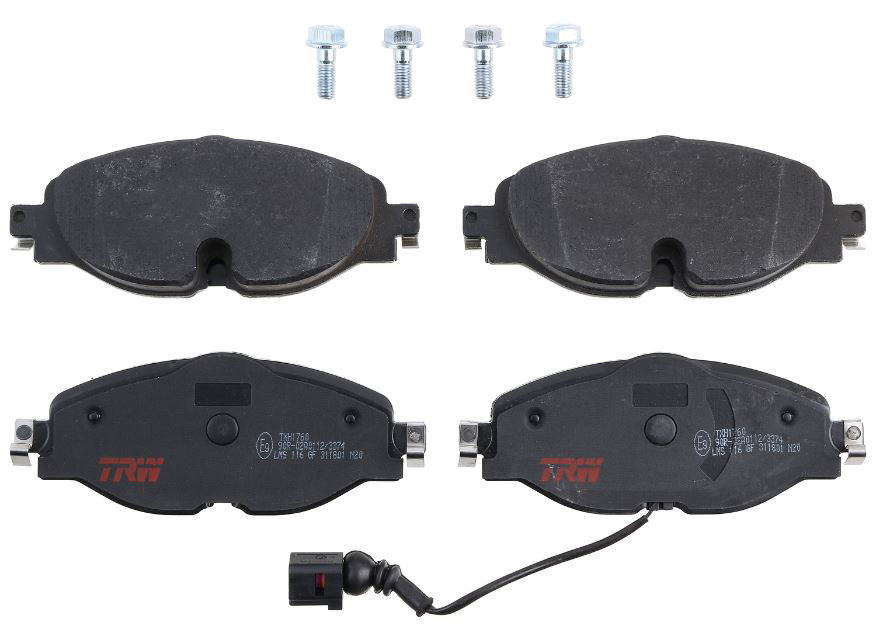It’s easy to forget about your car’s brake pads until they wear out. Then you’re suddenly confronted with a bunch of different replacement options—and you don’t know where to start.
Without a doubt, selecting the right brakes for your vehicle can be a challenge. But if you’re familiar with the different types of brake pads, you’ll be better prepared to make an informed decision.

Different Types of Brake Pads
Brake pads are simple parts that consists of friction material attached to a metal backing plate. In a disc brake system, there are a pair of brake pads behind each of the vehicle’s wheels.
When the driver applies the brakes, a device called the master cylinder transfers force from the brake pedal to the brake fluid. The fluid then travels through the brake lines and acts on a brake caliper at each wheel. Each caliper squeezes a set of brake pads against a disc-shaped rotor, creating the friction needed to bring the vehicle to a stop.
Brake pads are classified by the composition of their friction material. There are three primary types of brake pads, including non-metallic, semi-metallic, and ceramic. Carbon fiber brakes are also becoming more commonplace on high-end applications.

Non-Metallic
Non-metallic brake pads (also known as organic brake pads) can be made from various materials, including asbestos fibers. Typically, non-metallic brakes are the least expensive type of brake pad. Unfortunately, due to their composition, non-metallic pads also tend to wear out quickly and succumb to brake fade.
Semi-Metallic
Semi-metallic pads offer better performance and last longer than non-metallic brake pads. The downside is, because semi-metallic pads contain up to 70% metal, they can be noisy and create a lot of dust. Traditional semi-metallic pads are primarily made up of copper, iron, and steel.

Ceramic
Ceramic pads are one of the most expensive types of brake pads—but you get what you pay for. Ceramic brakes usually perform better, last longer, and create less dust than non-metallic or semi-metallic pads.
A typical ceramic pad contains ceramic fibers, along with other ingredients, such as carbon (or graphite) and various metals.

Carbon Fiber
Carbon fiber pads are the newest (and most expensive) type of brake pads. As you might guess, these pads contain a carbon mix with embedded fibers. You’ll usually find carbon fiber brake pads on race cars, air crafts, and other high-end applications.
Copper-Free and Low-Copper Brake Pads
Semi-metallic brake pads are primarily made up of metals, including steel, brass, and copper. Traditionally, ceramic brake pads have also contained some copper.
Copper works well as a friction medium because it dissipates heat quickly, thereby improving braking performance. The problem is, copper is also highly toxic to fish and other aquatic life. As the brake pads wear down, the copper from the brake dust gets washed into streams and rivers, harming the wildlife that lives there.
To address the problem, the states of California and Washington put new regulations in place at the beginning of 2021. Now, in either State, it’s illegal to install brake pads that contain more than 5% copper. Both states will also require copper-free brake pads by 2025.
You can learn more by reading our article on the copper-free brake initiative.

What Type of Brake Pads are Best?
Which type of brake pad is best for you will depend on several factors, including the kind of vehicle you have, your driving habits, and your budget.
If cost is your main concern when selecting new brakes, you might want to consider a set of non-metallic brake pads. Otherwise, it’s worth upgrading to a set of semi-metallic or ceramic brakes.
Metallic pads are somewhat of a middle ground between non-metallic and ceramic brake pads. Although metallic brake pads perform well (they’re often used on high-performance vehicles), they also create a significant amount of noise and brake dust.

Ceramic pads generally run quieter, produce less dust, and last longer than the other two types of brake pads. As a result, ceramic pads have become extremely popular. In fact, it’s estimated that up to 90% of new vehicles come with ceramic pads.
When selecting a new set of brakes, you’ll want to keep the characteristics of each type of pad in mind. Also, be sure to select a set of brake pads that will fit your vehicle and your lifestyle.
Order a Replacement Brake Pad in the Comfort of Your Home
It’s best to wait until you’ve replaced a bad brake pad before driving your vehicle again. Braking becomes more difficult with a worn-out or failing pad, and you might end up in a collision or crash that will cost you more. Instead, order a replacement brake pad that fits your car and budget here at CarParts.com.
Return your vehicle to the road faster with CarParts.com. We ship the brake pads you need when you need them. Our vehicle selector can find the most suitable products for your car after you enter several details, taking the guesswork and tedium out of shopping for auto parts. Furthermore, our strategically located auto parts warehouses use the latest technologies to process your order efficiently and deliver your new parts faster. You won’t have to wait long before your new brake pads arrive at your doorstep in pristine condition.
Why put up with a bad brake pad when CarParts.com makes ordering an affordable replacement easy? Shop now to enjoy the best deals on brake pads today!
Shop this Project



Any information provided on this Website is for informational purposes only and is not intended to replace consultation with a professional mechanic. The accuracy and timeliness of the information may change from the time of publication.

































so amazing post, cheers